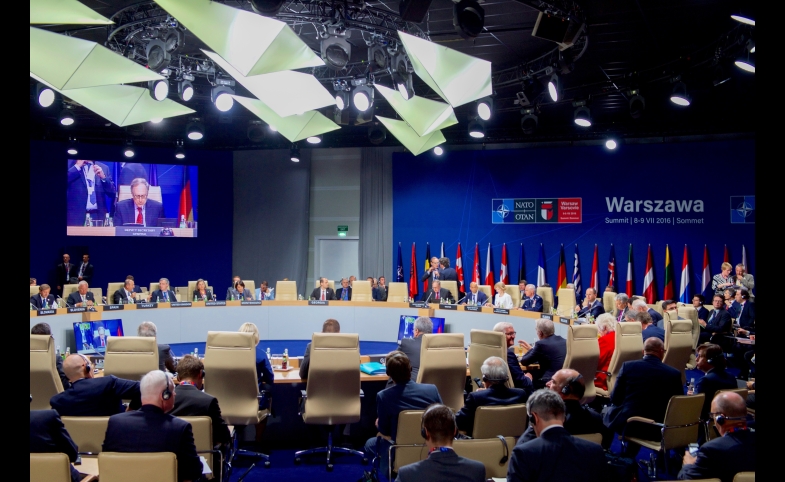NATO, the world’s most powerful military alliance, has recently released a strategy to counter hybrid threats. This strategy recognizes the fact that the security environment is neither dominated by conventional threats,...
KEEP READINGThe CPD Blog is intended to stimulate dialog among scholars and practitioners from around the world in the public diplomacy sphere. The opinions represented here are the authors' own and do not necessarily reflect CPD's views. For blogger guidelines, click here.

The NATO Warsaw Summit: An Example of Successful PD
NATO Summits are major events. While there is no rule of how often they take place, they tend to be bi-annual.
Hosted by one of the NATO Member states, they get branded and referred to by the name of the city they were hosted in. For example, NATO held its Prague Summit in 2002, Bucharest Summit in 2008 or Chicago Summit in 2012.
This year, NATO held its most important and highest level meeting at the level of Heads of States and Governments on 8-9 July in Warsaw, Poland, thus it will be remembered as the Warsaw Summit.
For two days, the capital of Poland became a place where many of the world's cameras aimed their lenses and where a flurry of activity at the Summit venue went on without interruption for 48 hours.
Even ahead of the Summit, media branded it as the "landmark" Summit, thus creating an aura of great expectations on the key decisions for an Alliance that faces an unprecedented number of security challenges on its territory and around its borders.
Over forty world leaders, including U.S. President Obama, German Chancellor Merkel, Afghan president Ghani and the President of the European Council Tusk met at the Warsaw Summit.
A 30-page long Summit Communique, a public document endorsed by the 28 Allies at the end of the Summit, provides an extensive overview of decisions taken to ensure and reinforce North Atlantic security.
And while the Summit is a key political event for NATO, it also provides an excellent platform for NATO’s public diplomacy.
Over 1500 journalists originating from NATO’s member states, its partner countries such as Afghanistan, Georgia, Ukraine, and from Argentina, China, Vietnam, attended the Warsaw Summit. In this time of tense relations between NATO and Russia, 34 Russian media representatives participated as well.
For two days in July, the world heard about NATO. The Warsaw Summit dominated headlines and front pages of all major key media outlets from CNN, BBC, Al-Jazeera, the Washington Post, and the Financial Times to national outlets in all participating nations.
NATO learned years ago how difficult it is to make people care about security and defense issues. How hard it is to make them aware about what NATO is and what it does.
The NATO Secretary General held 7 press conferences, gave 15 interviews and wrote several op-eds.
In the world of social media, NATO also filled up cyber space. While a detailed analysis of NATO’s social media exposure is still in progress, the first statistics show significant activity: NATO's Facebook page registered over 1 million organic reaches in 4 days. On NATO’s Twitter accounts, the buzz was significant – it reached 35 million impressions, 7,500 retweets and lot of further amplification by the Twitter activity of many leaders, ministers and journalists.
NATO's strong public diplomacy outreach program was in full swing weeks ahead of the Summit and in Warsaw. Hundreds of visitors came to NATO Headquarters in Brussels to learn about the decisions to be made at the Summit. Dozens of public diplomacy events such as seminars, conferences, and roundtables took place across the Allied countries to raise the interest of the expert audience in NATO’s Warsaw Summit.
An online quiz ran on NATO's Facebook page asking participants to answer questions about NATO to win a trip to Warsaw.
And the cherries on the cake were two exclusive public diplomacy events organized by NATO and its Polish and international partners in Warsaw during the Summit: a Young Leaders Forum with 64 young professionals from 34 countries and a Warsaw Summit Experts’ forum with over 350 well-known experts on security and foreign policy issues helped to maximize the Summit's reach. World leaders came to speak and mingle with the experts in a big tent erected in the vicinity of the stadium only for this particular occasion, underlining the importance that politicians give to such public diplomacy engagements.
The Polish hosts worked hard for months, together with the NATO team, to make the Warsaw Summit a success.
Leaving the judgement of the Summit's political success to the experts and commentators, I will say that the Warsaw Summit was indeed a public diplomacy success.
NATO learned years ago how difficult it is to make people care about security and defense issues. How hard it is to make them aware about what NATO is and what it does.
High-level events such as NATO Summits are a perfect opportunity to increase NATO’s visibility and receive the attention that an organization like NATO deserves in the world of so many varied security challenges.
NATO understands this. And therefore, the Warsaw Summit was an excellent example of a highly visible public diplomacy campaign.
Photo courtesy U.S. State Department | Public Domain
Visit CPD's Online Library
Explore CPD's vast online database featuring the latest books, articles, speeches and information on international organizations dedicated to public diplomacy.
POPULAR ARTICLES
-
November 21
-
November 7
-
November 5
-
October 24
-
November 21
Join the Conversation
Interested in contributing to the CPD Blog? We welcome your posts. Read our guidelines and find out how you can submit blogs and photo essays >.













